The AMD Radeon R9 290X Review
by Ryan Smith on October 24, 2013 12:01 AM EST- Posted in
- GPUs
- AMD
- Radeon
- Hawaii
- Radeon 200
Bioshock Infinite
Bioshock Infinite is Irrational Games’ latest entry in the Bioshock franchise. Though it’s based on Unreal Engine 3 – making it our obligatory UE3 game – Irrational had added a number of effects that make the game rather GPU-intensive on its highest settings. As an added bonus it includes a built-in benchmark composed of several scenes, a rarity for UE3 engine games, so we can easily get a good representation of what Bioshock’s performance is like.
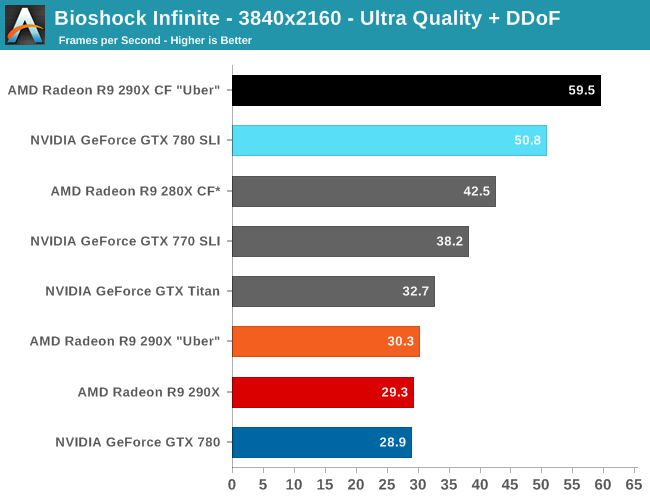

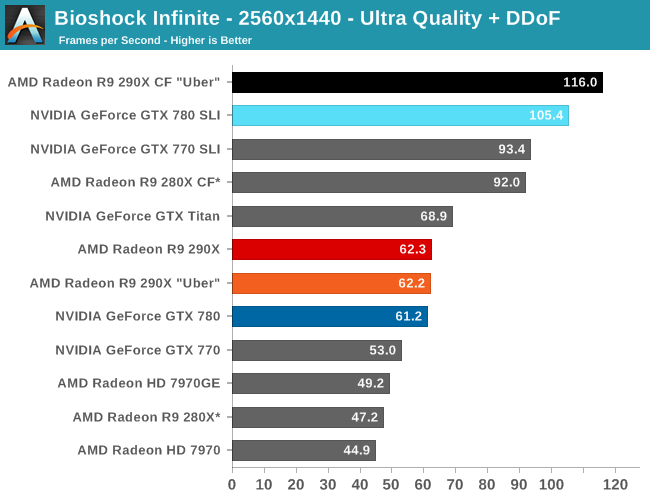
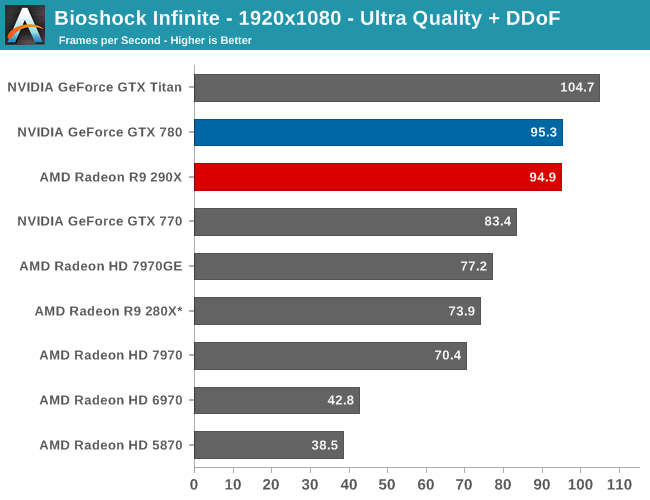
The first of the games AMD allowed us to publish results for, Bioshock is actually a straight up brawl between the 290X and the GTX 780 at 2560. The 290X’s performance advantage here is just 2%, much smaller than the earlier leads it enjoyed and essentially leaving the two cards tied, which also makes this one of the few games that 290X can’t match GTX Titan. At 2560 everything 290X/GTX 780 class or better can beat 60fps despite the heavy computational load of the depth of field effect, so for AMD 290X is the first single-GPU card from them that can pull this off.
Meanwhile at 4K things end up being rather split depending on the resolution we’re looking at. At Ultra quality the 290X and GTX 780 are again tied, but neither is above 30fps. Drop down to Medium quality however and we get framerates above 60fps again, while at the same time the 290X finally pulls away from the GTX 780, beating it by 14% and even edging out GTX Titan. Like so many games we’re looking at today the loss in quality cannot justify the higher resolution, in our opinion, but it presents another scenario where 290X demonstrates superior 4K performance.
For no-compromises 4K gaming we once again turn our gaze towards the 290X CF and GTX 780 SLI, which has AMD doing very well for themselves. While AMD and NVIDIA are nearly tied at the single GPU level – keep in mind we’re in uber mode for CF, so the uber 290X has a slight performance edge in single GPU mode – with multiple GPUs in play AMD sees better scaling from AFR and consequently better overall performance. At 95% the 290X achieves a nearly perfect scaling factor here, while the GTX 780 SLI achieves only 65%. Curiously this is better for AMD and worse for NVIDIA than the scaling factors we see at 2560, which are 86% and 72% respectively.
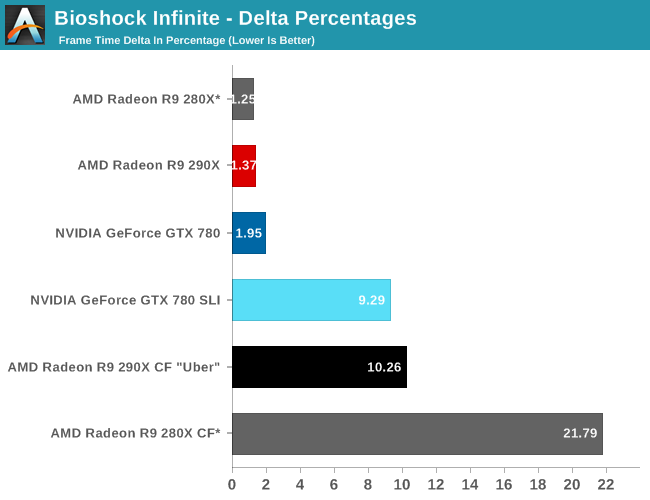

Moving on to our FCAT measurements, it’s interesting to see just how greatly improved the frame pacing is for the 290X versus the 280X, even with the frame pacing fixes in for the 280X. Whereas the 280X has deltas in excess of 21%, the 290X brings those deltas down to 10%, better than halving the variance in this game. Consequently the frame time consistency we’re seeing goes from being acceptable but measurably worse than NVIDIA’s consistency to essentially equal. In fact 10% is outright stunning for a multi-GPU setup, as we rarely achieve frame rates this consistent on those setups.
Finally for 4K gaming our variance increases a bit, but not immensely so. Despite the heavier rendering workload and greater demands on moving these large frames around, the delta percentages keep to 13%.


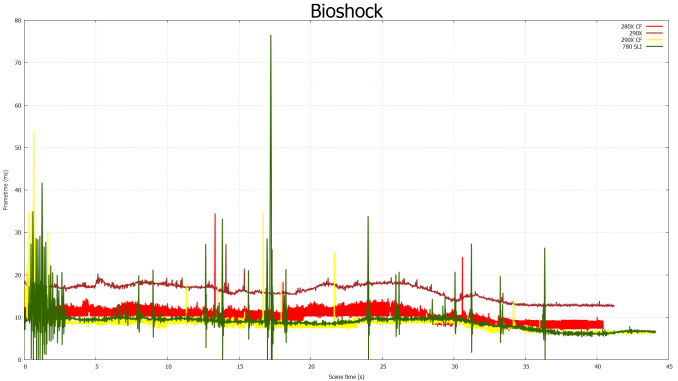









396 Comments
View All Comments
OverclockedCeleron - Thursday, October 24, 2013 - link
That made my day!pattycake0147 - Friday, October 25, 2013 - link
Yes! Comment of the day.TheinsanegamerN - Friday, October 25, 2013 - link
[reply in progress]OverclockedCeleron - Thursday, October 24, 2013 - link
Well done AMD, keep up the good work! Now it's the CPU turn ;).aTaoZ - Thursday, October 24, 2013 - link
Over in the overclocker uk forum, Gibbo is hinting the performance of non-x version in his 290X overclocking review. It is highly possible R9 290 will match GTX780 in performance at an even lower price.steelmilkjug - Friday, October 25, 2013 - link
It's good to see NVidia and AMD jockeying for the high end. Competition always helps keep prices realistic. Everytime I buy GPUs I go through the same mental struggle: Nvidia with better power/temp efficiency (roughly stated I know), AMD with slightly better price/performance ratios, sometimes significantly better. In the end, it always comes down to one thing for me: drivers. NVidia just seems to be more proactive in supporting their products, new drivers seem to come more often, and I feel the affect in games , usually. Less dual card issues, generally and a seemingly broader support of games in general. NVidia is a graphics hardware company specifically. AMD is not. They are a computer hardware company with a graphics department. And it shows. I'm an electrical engineer and I've seen how hard it is to get a job as an NVidia EE. It's a world renowned job, and they only pick the best in the world. I'm not sure AMD is quite as stringent.manicmonday - Friday, October 25, 2013 - link
So you think second tier engineers at AMD created a chip 25% smaller with better performance?SunLord - Friday, October 25, 2013 - link
Did Ryan quit or pass away 1/3 of the way through writing this review other this is pathetic so much for being a top tier review site.piroroadkill - Friday, October 25, 2013 - link
Yep. I gave them a while, some pages have now populated, but there are still too many empty ones. This is pretty poor.These days it seems like Apple gets all the coverage. Well, I couldn't really give a rats ass about massively long Apple articles. After all, Apple just wrap things up (such as GCN, Intel CPUs) into shiny boxes.
I think most of your readership is probably interested in the underlying tech, too.
Da W - Friday, October 25, 2013 - link
Man what do you do for a living? Quit bitching about other people's work, if you're not happy go somewhere else and STFU.